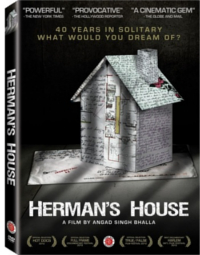 Herman’s House has an odd issue. At first it seems quite apparent that director Angad Bhalla’s debut suffers from a lack of focus, bobbing and weaving through topics as broad as human rights and our broken prison system to the more intricate appeal of an odd couple inspired to use art as a means to circumvent the prison bars that have confined one of them for decades. Yielding such fertile material, it seems strange then that each of these ideas is broken up into episodic segments spanning several years, but it isn’t until the credits roll that we realize the film’s true intent actually lies in our relationship with the structures we inhibit, how they subconsciously reflect our inner struggles and how, in turn, they impose themselves upon us, keeping us safe or keeping us captive, as in the case of Herman Wallace.
Herman’s House has an odd issue. At first it seems quite apparent that director Angad Bhalla’s debut suffers from a lack of focus, bobbing and weaving through topics as broad as human rights and our broken prison system to the more intricate appeal of an odd couple inspired to use art as a means to circumvent the prison bars that have confined one of them for decades. Yielding such fertile material, it seems strange then that each of these ideas is broken up into episodic segments spanning several years, but it isn’t until the credits roll that we realize the film’s true intent actually lies in our relationship with the structures we inhibit, how they subconsciously reflect our inner struggles and how, in turn, they impose themselves upon us, keeping us safe or keeping us captive, as in the case of Herman Wallace.
Over forty years ago, Wallace was dubbed as one of the Angola Three, a trio of pledged Panther party members slimly convicted of murdering a prison guard in the Angola Prison where they were being held. Since his conviction, he’s been held in solitary confinement with a bed, a toilet and all of a six-foot-by-nine-foot cell to himself. This prolonged separation is considered cruel and unusual punishment for many, but namely a young female woodworking artist by the name of Jackie Sumell. The fact that Wallace has been under such conditions for so long absolutely enraged her, so, not knowing where to funnel her animosity, she wrote Herman a letter and included photos of her everyday experience outside the prison walls. As if through serendipity, what started as written conversation developed into a massive art project between the two that dared to dream of a house based on Herman’s existence. By following the progress of Wallace and Sumell’s project, Bhalla’s doc opens up a perplexing conversation about their end game and the politics of the US prison system.
Unfortunately, Bhalla’s lens tends to lead us along tangents that distract from the emotive arc of Sumell and Wallace’s curious relationship. There’s a brief bit of background on Sumell’s history of activism, a short look at the Angola Three case, all of it held together by the continued development of their collaboration, but Bhalla’s true intention seems to rest in the subliminal text. It is the human relationship with one’s living space that the filmmaker actually investigates. Expanding from Herman’s oppressively tiny quarters, we see Sumell’s home change and expand, initiating the intimacy of family by inviting the neighborhood kids for dinner and instigating the anxieties of financially sustaining such an existence. While this visual discussion is a fascinating catch all for the footage found within the film, it feels a bit like Bhalla’s many potential parables couldn’t be funneled into a solid, fulfilling arc, so the needle was thread where it fit. Herman’s House supplants expectations by embracing the finer textures of suggestive storytelling, but in doing, the film feels a bit like a sobering joke that takes slightly too long to reach the punchline. With a little endurance and a perceptive eye you’ll find what seems obvious to begin with – every house is not a home.
Disc Review:
Herman’s House received its first home release, appropriately, from docu forerunners First Run Features. Merging subtle animation with walk and talk footage of Sumell, the film is presented with a clean, but unremarkable image. The 5.1 audio track provides more than adequate fidelity to the conversation focused film. Much of this chatter is Herman’s voice recorded over a low quality prison phone and played back as voiceover or occasionally as a live call with Sumell. The disc itself comes packaged in a standard DVD case.
Cinema Politica Interviews Director Angad Bhalla
Seated amidst a sea of cushy theater chairs, Bhalla talks about his current projects in production and what Herman’s House was meant to be about.
Deleted Scenes
In these scenes left on the cutting room floor, Bhalla spends extra time with the men that have been released from prison, but both spent plenty of their own time in solitary as Herman has. Robert King and Michael Musser speak about their time behind bars and how they’ve had to adjust to normal life once again.
Final Thoughts:
Where Herman’s House finds its strength is in it’s thematic simplicity, but strangely this almost seems like an accidental side effect of it’s haphazard construction. That said, Herman’s morally questionable, ultimately tragic story is definitely worth pondering, and Sumell’s art project proves a poignant segue into deep conversations on US prison regulations and human rights. Bhalla’s film makes for a curious watch, but it’s certainly no stunner.


